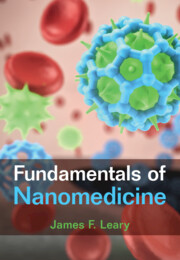Book contents
- Fundamentals of Nanomedicine
- Fundamentals of Nanomedicine
- Copyright page
- Dedication
- Contents
- Preface
- Acknowledgments
- 1 The Need for New Perspectives in Medicine
- 2 Nanomedicine: Single-Cell Medicine
- 3 Targeted Drug Delivery
- 4 Drug Delivery Cell Entry Mechanisms
- 5 Nanomaterial Cores for Noninvasive Imaging
- 6 Attaching Biomolecules to Nanoparticles
- 7 Characterizing Nanoparticles
- 8 Nanomedicine Drug Dosing
- 9 Nanodelivery of Therapeutic Genes
- 10 Assessing Nanomedical Therapies at the Single-Cell Level
- 11 Nanotoxicity at the Single-Cell Level
- 12 Designing Nanodelivery Systems for In Vivo Use
- 13 Designing and Testing Nanomedical Devices
- 14 Quality Assurance and Regulatory Issues of Nanomedicine for the Pharmaceutical Industry
- References
- Index
7 - Characterizing Nanoparticles
Published online by Cambridge University Press: 08 March 2022
- Fundamentals of Nanomedicine
- Fundamentals of Nanomedicine
- Copyright page
- Dedication
- Contents
- Preface
- Acknowledgments
- 1 The Need for New Perspectives in Medicine
- 2 Nanomedicine: Single-Cell Medicine
- 3 Targeted Drug Delivery
- 4 Drug Delivery Cell Entry Mechanisms
- 5 Nanomaterial Cores for Noninvasive Imaging
- 6 Attaching Biomolecules to Nanoparticles
- 7 Characterizing Nanoparticles
- 8 Nanomedicine Drug Dosing
- 9 Nanodelivery of Therapeutic Genes
- 10 Assessing Nanomedical Therapies at the Single-Cell Level
- 11 Nanotoxicity at the Single-Cell Level
- 12 Designing Nanodelivery Systems for In Vivo Use
- 13 Designing and Testing Nanomedical Devices
- 14 Quality Assurance and Regulatory Issues of Nanomedicine for the Pharmaceutical Industry
- References
- Index
Summary
This is the only chapter of the book devoted to the characterizations and measurements of the nanoparticles themselves, although it does include material related to the interaction forces between nanoparticles and cells. Zeta potential is probably the most important factor in determining whether nanoparticles will agglomerate in clusters. If you observe agglomeration happening to your nanoparticles (a very common problem), it is likely to be a problem with the zeta potential of your nanoparticles. The focus of the chapter is on the importance of “zeta potential,” which governs the fundamental electrostatic interactions of nanoparticles with each other as well as nanoparticle interactions with cells in an aqueous environment. Zeta potential is perhaps the single most important design consideration of nanomedical systems.
Keywords
- Type
- Chapter
- Information
- Fundamentals of Nanomedicine , pp. 122 - 142Publisher: Cambridge University PressPrint publication year: 2022

